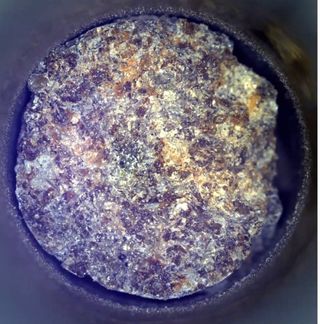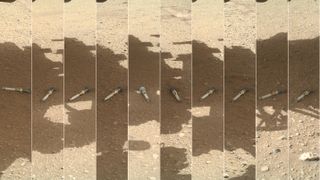The chief scientist of NASA’s Perseverance Mars rover is excited about material stored in the rover’s sample tubes, dropped both on the surface of Mars and in the rover itself while orbiting Jezero Crater.
Given the Martian samples Perseverance has collected so far, could one of those be what the rover was meant to look for in the first place: evidence of past microbial life on the Red Planet?
The preliminary finding increases the need to return these Mars samples to Earth so that these prized collectibles from the Red Planet can be sent to laboratories for more rigorous analyses.
Related: If life exists on Mars, don’t count on sample return missions to find it, scientists say
Lively question
Caltech’s Kenneth Farley, project scientist for NASA’s Perseverance Mars rover program, briefed the Extraterrestrial Materials Analysis Group (ExMAG) during a meeting May 13 to 15 in Houston, Texas.
Tagped “Lefroy Bay,” Farley drew attention to this sample collected by the Perseverance rover that was found to contain hydrated silica. Here on Earth, that mineral has the greatest potential to preserve signs of ancient life.
So a vivid question arises that lacks an answer: perhaps Lefroy Bay contains preserved signs of ancient life on Mars?

Paleoenvironmental conditions
“The Lefroy Bay sample and two other samples from the same unit – the ‘Margin Unit’ – are aboard Perseverance,” Farley told Space.com. “The Margin Unit samples contain abundant carbonate and silica, clearly indicating a dominant role for liquid water in their formation,” he said.
But whether that water was surface water in a lake or river, or groundwater, remains uncertain, Farley added. Both could form an ancient (more than 3.4 billion years old), habitable Martian environment, he said.
These samples harbor phases that are very useful on Earth for establishing “paleoenvironmental” conditions, Farley noted, and they may also preserve biosignatures. “As such, these samples are of unique importance for return to Earth for further study,” Farley said.

Purpose: set in stone
Perseverance is “about to make a really fundamental transition in the exploration of the environment in which we have been working,” Farley explained in his briefing to the ExMAG. “One of the challenges we face,” he said, “is that this is not great terrain to drive a rover through.”
So far, the Mars machine has traveled about 17 miles after it was lowered to the area by sky crane on February 18, 2021. The robot’s purpose is set in stone: ‘Search for signs of ancient life and collect rock samples. and regolith for a possible return to Earth,” NASA explains.
But why was the 45-kilometer-wide Jezero crater chosen as the rover’s exploration site?

Scientists believe that the area was once flooded with water and that there was an ancient river delta here. The Jezero crater is expected to quite literally “spill the beans” about its on-again, off-again nature of Mars’ wet past. More than 3.5 billion years ago, river channels flowed over the crater wall and created a lake.
What is possible is that microbial life could have lived in Jezero during one or more of those wet periods. If true, traces of the remains of these little critters could be discovered in the bottom of a lake or in the sediments of the shoreline.
Rover Challenges
As for the overall health of the Perseverance rover, Farley noted a number of issues: first, the loss of wind sensors that are part of the Mars Environmental Dynamics Analyzer (MEDA), built by an international team led by Spain’s Centro de Astrobiología . “We have lost most of the wind sensors. They basically no longer function,” he reported.
The spectroscopy components of the robot arm-mounted Scanning Habitable Environments with Raman & Luminescence for Organics & Chemicals, or SHERLOC for short, are also challenged. This is because a lens cap no longer works properly. However, some preliminary work has been done that suggests scientists may be able to restore SHERLOC’s spectroscopy capabilities. “We’ll know more about that in the coming months,” Farley said.
Three Forks Depot
The rover was sent to Mars with 38 tubes that could be used for rock, regolith and even atmospheric sampling. “We’re about two-thirds of the way through the sample collection,” Farley explains.
The robot on duty sampled igneous rocks, mudstone, sandstone/pebble conglomerate, carbonate-silica-olivine and Martian sand at the top and sniffed a whiff of the Martian atmosphere.
Earlier in its trek to Mars, Perseverance dropped ten sealed sample tubes at a depot site called “Three Forks” in Jezero Crater. The idea is that in the future, a Mars Sample Return (MSR) mission would pick up sample tubes and shoot those bits and pieces from Mars to Earth.
However, this joint venture between NASA and the European Space Agency is now under major review due to the expected $11 billion price tag and the expected but unsatisfactory timeframe to complete such a complex undertaking.

Stay the course
Farley told the ExMAG Group that rover operators are working to qualify Perseverance for a 56-mile traverse so it can make its way into a vibrant landscape.
“There’s obviously a tremendous amount of uncertainty about what the MSR is going to be. We’re waiting to hear how we’re going to factor into that during the Perseverance mission,” Farley said. “But for now, we’re staying the course. We’ll continue to conduct ourselves essentially as we have done so far, with a strong focus on sample collection.”
The rover’s itinerary now includes completing tasks in an area called Bright Angel, then moving up to the crater rim, where the rover can explore fundamentally different geology, Farley added.
When climbing the rim, “we will complete the sampling quickly. The sooner we get the sampling done, the sooner we can all rest assured… that we’ve done our job,” Farley said.
What happens next for Perseverance is TBD.
“Maybe we’ll return to the crater floor to meet MSR, maybe not. It will depend on what actually happens to MSR,” Farley concluded.
Editor’s Note: The original version of this story included this sentence: “Looking at the Martian samples Perseverance collected, scientists say one tube appears to be full of what the rover was looking for: evidence of past microbial life on the Red Planet .” However, that is too strong a statement; the story was edited on May 20 at 7:15 PM ET to replace the above with the following: “Given the Martian samples Perseverance has collected so far, one of those could be what the rover was meant to look for in space ? first place: evidence of past microbial life on the Red Planet?”